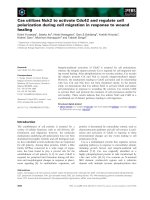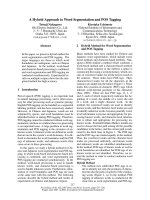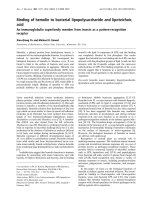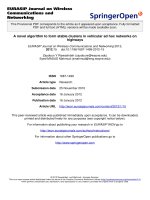Báo cáo toán học: "Continued fractions related to (t, q)-tangents and variants" ppsx
Bạn đang xem bản rút gọn của tài liệu. Xem và tải ngay bản đầy đủ của tài liệu tại đây (80.68 KB, 7 trang )
Continued fractions related to
(t, q)-tangents and variants
Helmut Prodinger
Department of Mathematics
7602 Stellenbosch, South Africa
Submitted: May 16, 2011; Accepted: Aug 3, 2011; Published: Au g 19, 2011
Mathematics Subject C lassifications: 05A30, 05A10
To Doron Zeilberger who turned me into an addict of creative guessing
Abstract
For the q-tangent function introduced by Foata and Han (this volume) we provide
the continued fr action expansion, by creative guessing and a routine verification.
Then an even more recent q-tangent function due to Cieslinski is also exp anded.
Lastly, a general version is considered that contains both versions as special cases.
1 Foata and Han’s tangent function
Foata and Han [3] defined
sin
(r)
q
(u) =
n≥0
(−1)
n
(q
r
; q)
2n+1
(q; q)
2n+1
u
2n+1
,
cos
(r)
q
(u) =
n≥0
(−1)
n
(q
r
; q)
2n
(q; q)
2n
u
2n
,
tan
(r)
q
(u) =
sin
(r)
q
(u)
cos
(r)
q
(u)
.
Here we use the (classic) notation, where we assume |q| < 1:
(x; q)
n
:= (1 − x)(1 − xq) . . . (1 − xq
n−1
).
Note that for r → ∞, we obtain the classic q-tangent function of Jackson’s [5].
the electronic journal of combinatorics 18(2) (2011), #P18 1
In this paper, we compute the continued f r action expansion of this new q-tangent
function. In the spirit of Zeilberger, the coefficients in it (a
k
in the sequel) were obtained
first by gues s i ng them. After that, some additional power series s
k
(z) were also guessed
(using the recursion that la t er will be proved). Once one has them, the proof of a recursion
for s
k
(z) is routine, and turns immediately into the continued fraction expansion. In a
sense, this is the most elementary approach possible.
Set, for k ≥ −1,
s
k
(z) := q
(
k+1
2
)
n≥0
(q
r−k
; q
2
)
k+n+1
(q
r+k+1
; q
2
)
n
(q; q
2
)
k+n+1
(q
2
; q
2
)
n
z
n
,
and for k ≥ 0
a
k
=
(q
r+1−k
; q
2
)
k
(1 − q
2k+1
)
(q
r−k
; q
2
)
k+1
q
k
.
Note that for r → ∞, we obtain
a
k
=
1 − q
2k+1
q
k
,
which are the well-known coefficients for the classic q-tangent function.
Now we compute
[z
n
]
s
k−1
(z) − a
k
s
k
(z)
= q
(
k
2
)
(q
r+1−k
; q
2
)
k+n
(q
r+k
; q
2
)
n
(q; q
2
)
k+n
(q
2
; q
2
)
n
−
(q
r+1−k
; q
2
)
k
(1 − q
2k+1
)
(q
r−k
; q
2
)
k+1
q
k
q
(
k+1
2
)
(q
r−k
; q
2
)
k+n+1
(q
r+k+1
; q
2
)
n
(q; q
2
)
k+n+1
(q
2
; q
2
)
n
= q
(
k
2
)
(q
r−k
; q
2
)
k+n+1
(q
r+k+1
; q
2
)
n
(q; q
2
)
k+n+1
(q
2
; q
2
)
n
×
(q
r+1−k
; q
2
)
k
(1 − q
2k+2n+1
)
(q
r−k
; q
2
)
k
(1 − q
r+k+2n
)
−
(q
r+1−k
; q
2
)
k
(1 − q
2k+1
)
(q
r−k
; q
2
)
k+1
= q
(
k
2
)
(q
r−k
; q
2
)
k+n+1
(q
r+k+1
; q
2
)
n
(q
r+1−k
; q
2
)
k
(q; q
2
)
k+n+1
(q
2
; q
2
)
n
(q
r−k
; q
2
)
k
1 − q
2k+2n+1
1 − q
r+k+2n
−
1 − q
2k+1
1 − q
r+k
= q
(
k
2
)
(q
r−k
; q
2
)
k+n+1
(q
r+k+1
; q
2
)
n
(q
r+1−k
; q
2
)
k
(q; q
2
)
k+n+1
(q
2
; q
2
)
n
(q
r−k
; q
2
)
k
q
2k+1
(1 − q
2n
)(1 − q
r−k−1
)
(1 − q
r+k+2n
)(1 − q
r+k
)
= q
(
k+1
2
)
(q
r−k
; q
2
)
k+n
(q
r+k+1
; q
2
)
n
(q
r−1−k
; q
2
)
k+1
(q; q
2
)
k+n+1
(q
2
; q
2
)
n−1
(q
r−k
; q
2
)
k+1
= q
(
k+1
2
)
(q
r−1−k
; q
2
)
k+n+1
(q
r+k+2
; q
2
)
n−1
(q; q
2
)
k+n+1
(q
2
; q
2
)
n−1
= [z
n−1
]s
k+1
(z).
Since the constant term in this difference cancels out, we found the recurrence
s
k−1
(z) − a
k
s
k
(z) = zs
k+1
(z).
the electronic journal of combinatorics 18(2) (2011), #P18 2
Therefore we have
zs
0
s
−1
=
zs
0
a
0
s
0
+ zs
1
=
z
a
0
+
zs
1
s
0
=
z
a
0
+
z
a
1
+
z
a
2
+
z
. . .
.
If r is a positive integer, this continued fra ction expansions stops, since s
r
(z) = 0.
Replacing z by −z we get
zs
0
(−z)
s
−1
(−z)
=
z
a
0
−
z
a
1
−
z
a
2
−
z
. . .
.
This translates into a continued fraction of tan
(r)
q
(u):
tan
(r)
q
(u) =
u
a
0
−
u
2
a
1
−
u
2
a
2
−
u
2
. . .
.
2 Cieslinski’s new q-tangent
After a first draft about the Foata and Han q-tangent was produced, a further q-
tangent function was introduced by Cieslinski [1]. Recall that Jackson’s [5] classical
q-trigonometric functions are defined as
sin
q
z =
n≥0
(−1)
n
z
2n+1
(q; q)
2n+1
,
cos
q
z =
n≥0
(−1)
n
z
2n
(q; q)
2n
.
Sometimes, instead of (q; q)
n
, the term (q; q)
n
/(1 − q)
n
is used, but that is clearly
just a change of variable. The corresponding tangent function is defined by tan
q
z =
sin
q
z/ cos
q
z.
Cieslinski [1] introduced new (“improved”?) q-trigonometric functions:
Sin
q
(2z) =
2 tan
q
z
1 + tan
2
q
z
,
the electronic journal of combinatorics 18(2) (2011), #P18 3
Cos
q
(2z) =
1 − tan
2
q
z
1 + tan
2
q
z
.
Of course, this also introduces a (new) q-tangent f unction: Tan
q
(z) = Sin
q
(z)/Cos
q
(z).
As we know, q-tangents are good candidates f or beautiful continued fraction expan-
sions [6, 4, 7, 8]; and this is confirmed by the results of the previous section. This new
version is no exception; we are going to prove that
z Tan( 2 z) =
z
2
a
0
+
z
2
a
1
+
z
2
. . .
with
a
2k
=
(1 − q
4k+1
)(−q; q
2
)
2
k
2q
k
(−q
2
; q
2
)
2
k
,
a
2k+1
= −
2(1 − q
4k+3
)(−q
2
; q
2
)
2
k
q
k
(−q; q
2
)
2
k+1
.
As b efo re, we obtain all the relevant quantities first by guessing them.
First, we need the power series expansions of sine and cosine:
Sin
q
(2z) =
n≥0
z
2n+1
(−1)
n
(−1; q)
2n+1
(q; q)
2n+1
,
Cos
q
(2z) =
n≥0
z
2n
(−1)
n
(−1; q)
2n
(q; q)
2n
.
Cieslinski [1] has given t he representations
Sin
q
(2z) =
e
iz
q
E
iz
q
− e
−iz
q
E
−iz
q
2i
,
Cos
q
(2z) =
e
iz
q
E
iz
q
+ e
−iz
q
E
−iz
q
2
,
with
e
z
q
=
n≥0
z
n
(q; q)
n
, E
z
q
=
n≥0
z
n
q
(
n
2
)
(q; q)
n
.
Fro m this, the desired expansions follow from comparing coefficients and simple q-
identities.
Now define
σ
0
:=
n≥0
z
n
(−1)
n
(−1; q)
2n+1
(q; q)
2n+1
,
σ
−1
:=
n≥0
z
n
(−1)
n
(−1; q)
2n
(q; q)
2n
the electronic journal of combinatorics 18(2) (2011), #P18 4
and, more generally,
σ
2k
=
q
k
2
(−1)
k
(−q
2
; q
2
)
k
(−q; q
2
)
k
n≥0
z
n
(−1)
n
(−1; q)
2k+2n+1
(q; q
2
)
2k+n+1
(q
2
; q
2
)
n
,
σ
2k+1
=
q
k
2
+k
(−1)
k+1
(−q
2
; q
2
)
k+1
(−1; q
2
)
k+1
n≥0
z
n
(−1)
n
(−1; q)
2k+2n+1
(q; q
2
)
2k+n+2
(q
2
; q
2
)
n
.
As in the previous section, we obtain the recursion
σ
i+1
=
σ
i−1
− a
i
σ
i
z
by a routine computation.
Consequently, we can write
zσ
0
σ
−1
=
zσ
0
a
0
σ
0
+ zσ
1
=
z
a
0
+
zσ
1
σ
0
=
z
a
0
+
z
a
1
+
zσ
2
σ
1
=
z
a
0
+
z
a
1
+
z
a
2
+
z
. . .
.
The claimed continued fraction expansion of z Tan(2z) follows from this by substituting
z by z
2
.
I was informed that this expansion could also be derived using results of Denis [2].
The present elementary approach should, however, not be without merits.
3 A uniform approach to the two q-tangents
It is apparent that
sin
q
(u) =
n≥0
(−1)
n
(w; q)
2n+1
(q; q)
2n+1
u
2n+1
,
cos
q
(u) =
n≥0
(−1)
n
(w; q)
2n
(q; q)
2n
u
2n
,
tan
q
(u) =
sin
q
(u)
cos
q
(u)
generalises for w = q
r
the Foata and Han version, and for w = −1 the Cieslinski version.
Our elementary approach can handle this situation as well:
Set
σ
0
(z) =
n≥0
(w; q)
2n+1
(q; q)
2n+1
z
n
,
σ
−1
(z) =
n≥0
(w; q)
2n
(q; q)
2n
z
n
,
the electronic journal of combinatorics 18(2) (2011), #P18 5
then
a
k
=
(wq
1−k
; q
2
)
k
(1 − q
2k+1
)
(wq
−k
; q
2
)
k+1
q
k
and
σ
k
(z) = q
k(k+1)
2
n≥0
z
n
(wq
−k
; q
2
)
n+k+1
(wq
k+1
; q
2
)
n
(q; q
2
)
n+k+1
(q
2
; q
2
)
n
.
As b efo re, we get
σ
k+1
=
σ
k−1
− a
k
σ
k
z
and
zσ
0
(z)
σ
−1
(z)
=
z
a
0
+
z
a
1
+
z
a
2
+
z
. . .
.
This gives the expansion of the q-tangent:
zσ
0
(−z
2
)
σ
−1
(−z
2
)
=
z
a
0
−
z
2
a
1
−
z
2
a
2
−
z
2
. . .
.
References
[1] J. L. Cieslinski. Improved q-exp onential and q-trigonometric functions. Appl. Math.
Lett., to appear, 2011.
[2] R. Y. Denis. On (a) generalization of (a) continued fr action of G auss. Int. J. Math.
Math. Sci . , 4:741–7 46, 1990.
[3] D. Foata and G N. Han. The (t, q)-analogs of secant a nd tangent numbers. Electronic
Journal of Combina torics , 18(2):#P 7, 2011.
[4] M. Fulmek. A continued fraction expansion for a q-tangent function. S´em. Lothar.
Combin., 45:Art. B45b, 5 pp. (electronic), 2000/0 1.
[5] F. H. Jackson. A basic-sine a nd cosine with symbolic solutions of certain differential
equations. Proc. Edinburg Math. Soc., 22:28–39, 1904.
[6] H. Prodinger. Combinatorics of geometrically distributed random variables: new q-
tangent and q-secant numbers. Int. J. Math. Math. Sci., 24(12):82 5–838, 2000.
the electronic journal of combinatorics 18(2) (2011), #P18 6
[7] H. Prodinger. A continued fraction expansion for a q-tangent function: an elementary
proof . S´em. Lothar. Combin., 60:Art. B60b, 3, 2008/09.
[8] H. Prodinger. Continued fraction expansions for q-tangent and q-cotangent functions.
Discrete Math. Theor. Comput. Sci., 12(2):47–64, 2010.
the electronic journal of combinatorics 18(2) (2011), #P18 7









